All 2 entries tagged Identity
View all 13 entries tagged Identity on Warwick Blogs | View entries tagged Identity at Technorati | There are no images tagged Identity on this blog
September 01, 2019
Achaean League Coinage and Collective Identity
On the Greek mainland in the Hellenistic Period, some of the city states united into federal leagues, the most successful of these being the Achaean League. In my undergraduate dissertation I wanted to show how the Achaean League developed its collective identity and how this affected the policy and the society of the League. Collective identity is how states and individuals can identify with both their home city and the overarching political body (i.e. a modern example is me saying I am both European and British). The coinage of the Achaean League acted as a means of spreading this message throughout the League. In this blogpost, I’m going to show how the coinage reflected the policy of collective identity. To examine this topic in depth I’m going to examine a coin from Megara and how the Megarians reconciled the ‘Dorian’ and ‘Achaean’ aspects of their identity.
Types of Achaean Coinage
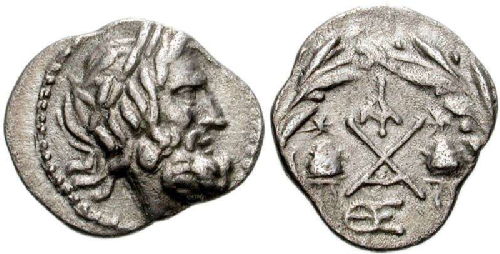 |
Achaean Hemidrachm, minted at Sparta, with symbol of Dioscuri caps and abbreviation of LA on the reverse, and head of Zeus Homarius on the obverse.
Polybius proudly states that the Achaeans “formed the states into a community of allies and friends, but they have also adopted the same laws, weights and measures and coinage…” (Polybius, Histories, 2.37). This has been interpreted as a way of showing “the social and political solidarity of the second-century Peloponnese.” (Thonemann (2015) 72). These coins were silver hemidrachms, worth half a drachm, and were minted in nineteen different poleis of the Achaean League. Each of these cities produced the coins to a similar blueprint: a head of Zeus Homarius on the obverse, and a monogram of the word Achaean on the reverse. The different mints are indicated with either abbreviations or with symbols, such as the Pegasus of Corinth.
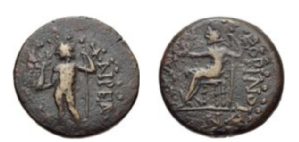 |
Achaean tetrachalkon, minted at Corinth, Obverse: Zeus with sceptre and holding Nike in his hand. Reverse: Seated figure of the personified Achaea. Both motifs were common throughout the Hellenistic World.
These ethnics and symbols helped to bind the cities to the league by associating them with the federal Achaean body and making them as one and the same, whilst celebrating the individual characters of the cities themselves; it shows dedication to the federal ideal. This is further proved by the bronze coinage of the league, which was struck in over forty-five out of the seventy odd cities in the league. These small poleis were committed to the league and were willing to invest heavily in that relationship. Warren suggests that over 1600 dies were used in the minting of these bronze coins, which is an extremely heavy investment, especially compared to how other poleis minted coins in the Hellenistic Period (Warren (2007); Thonemann (2015) 74).
Maintaining local identity in a federal state
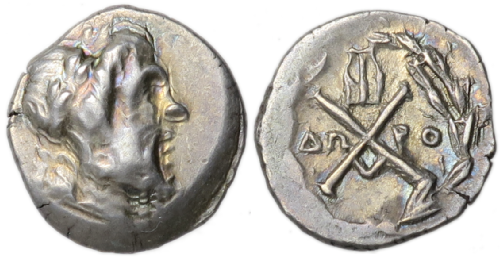 |
Achaean Hemidrachm, minted at Megara. Obverse: Head of Zeus Homarius. Reverse: Achaean League monogram and abbreviation of word Dorian.
The collective identity of the Achaean League didn’t mean that various local identities were weakened. In fact, the network of poleis meant that they strengthened their local identities, and the environment of competition between the constituent members changed. Coinage was one media that expressed this.
This coin from Megara helps to show the nuance that went into how the ancient Greeks identified themselves. Across the Achaean monogram is the abbreviated ethnic, but rather than denoting the city of Megara, it draws attention to the Greek ethnic group of the Dorians. The Egyptologist Lynn Meskell has said that “identity is what is draped over a person by the groups of which he or she is part” ((1999) 32), indicating that identity is multi-faceted and complex, consisting of many layers. The complicated layers of this coin show that the people of Megara want to advertise their history as Dorians, and the political reality of their position as members of the Achaean League. One did not trump the other, and from the view of inter-polis competition, the historical baggage of the term will have had an effect on how Megara was received within the league.
Conclusion
This examination of Achaean coinage has shown how integrated the society of the Achaeans was, and that whilst Polybius’ assertion that the Peloponnese was a “single state” (2.37) is apt, the situation was a lot more complicated. Each member state had its own agenda and history, but worked under the umbrella of Achaean identity in order to be stronger and more efficient (Close (2018)). The coinage of the various states of the Peloponnese show how these states were able to reconcile the identities that both united them and showcased their uniqueness.
Bibliography
Primary
Polybius, Histories, trans. Waterfield, R. Oxford University Press: Oxford 2010.
Secondary
Close, E. “Megalopolis and the Achaean Koinon: Local Identity and the Federal State.” Teiresias 48.1 2018: 2–8.
Meskell, L. 1999. Archaeologies of Social Life. Oxford: Blackwell Publishing Ltd.
Thonemann, P. 2015. The Hellenistic World: Using Coins as Sources. Cambridge University Press: Cambridge.
Warren, J. 2007. The Bronze Coinage of the Achaion Koinon: the Currency of a Federal Ideal. London: Royal Numismatic Society.
 |
This month’s entry was written by Jameson Minto, who recently graduated from Warwick. His dissertation was titled ‘The Achaean League and Collective Identity’ and dealt with the evolution of both the institutions of the league and the creation of the Achaean identity. Jameson runs his own blog, Musings of Clio, which discusses the ancient world, and he is set to study an MA in Classics and Ancient History at the University of Manchester.
September 01, 2015
Dionysiac Dolphins: coinage and social identity
 |
| Dolphin coin of Olbia (SNG BM Black Sea 360) |
This dolphin-shaped money was found at Olbia, a trading colony of Miletus on the coast of the Black Sea, and dates from the late sixth century. The coins are made of bronze, and are approximately 35mm in length. Archaeologists believe the use of these pieces to be monetary because they carry leaders’ names and are found in hoards and in tombs. Although the dolphins were eventually replaced by more conventional round currency which incorporated the image of a dolphin into its design, the dolphin shape builds on a Greek tradition of using dolphin iconography as a way of representing the internal struggle to define identity in the face of increased interaction with foreign culture.
Dolphin imagery is used in both literary and artistic depictions of Greek culture in the time of colonisation, embodying the separation between Greece and the outside world. The distinction between self and other played an increasingly important role in the lives of Greeks as colonisation and trade grew. The need for outside materials such as grain (which did not grow well in Greece) or metals and the need for land (a requirement for citizenship) increased awareness of the cultural and linguistic differences between Greeks and non-Greeks. This heightened the urgency with which the Greeks began to define themselves.
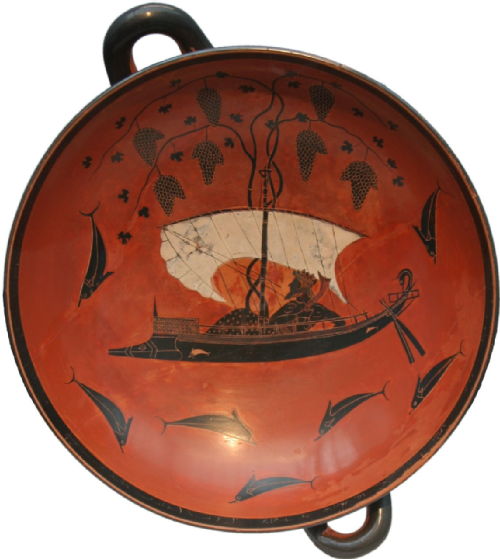 |
|
Dionysus sailing surrounded
by dolphins.
|
One literary depiction of the dolphin is in Herodotus (1.23): a dolphin rescues Arion from death at the hands of rogue sailors during a war against Miletus. The Histories are full of contrasts: home and away; barbarism and civilisation. This story uses these contrasts to explore the dichotomous and fraught relationship Greece was developing with the outside world. The dolphin in this instance represents a protector of civilisation by rescuing the creator of dithyramb (a sympotic song, sung in honour of Dionysus): a core part of the established social patterns of Greek culture. Although the sailors were also Greek they demonstrate a loss of civility having left behind the civilisation of Greece: once Arion returns to Greece, he is again honoured.
Archilochus discussed the opposition between land and sea, creating a sense of opposition between the safety of Greece and the uncertainty of sea-faring: “the forest beasts remove to dolphins’ salty fields, finding roaring waves a sweeter home than land” (122W). Although this colonisation is not the primary context of the fragment, the use of contrast and sea imagery clearly references the use of the sea to explore new territory. Contextually, this poetry would be performed at symposia and perhaps not in the traditional sense: Carey (2009) notes the possibility that the symposium was removed to the ship – the performed lines reflect the literal situation of the sailors, allowing them to define themselves as a group separate to Greece, using the habitat of the dolphins to create a home-away-from-home for themselves.
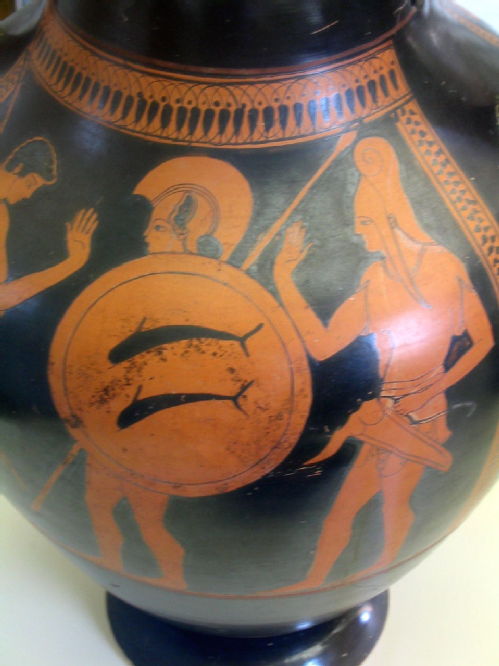 |
| Hoplite warrior
with shield
|
In art, the use of the dolphins is also connected to the symposium: Dionysus rides through the sea on a boat surrounded by dolphins, with vines growing above his head. The idea of nautical transportation not only connects to colonisation, but also to the “long distances” drinkers traversed through wine (Davidson, 1998). The symposium offered a space for self-discovery, performance of the self, and exploration of the new world the Greeks were facing. The symposium is linked intrinsically to the story of Arion, creator of the Dithyramb through the musicality and theatricality of the symposium, the dolphins acting as a “visual projection of dithyrambic chorality” (Kowalzig, 2013). Dolphin iconography here then demonstrates both the physical and mental transportation of Greek cultural awareness and definition.
In other vases, dolphins appear in the context of warfare, playing antipathetic roles of protection and attack. In the context of the hoplite, the dolphins are seen being ridden into battle, and also on the shield: they are figured as a Greek asset, turning the sea into a battlefield both physically in the form of naumachy but also figuratively in terms of the mental battle between need for expansion and will for Hellenist isolation. The sea is being claimed as Greek through the appropriation of the dolphin.
 |
|
Hoplite warriors riding
dolphins into battle.
|
The use of dolphin iconography in the Olbian coin can arguably be considered to be about identity. Although the evidence discussed so far has explored how the Greeks used the dolphin to figure their identity, this is also an important question for a colony with significant outside interaction from trade. Olbia is not the only colony to use the dolphin image in this way: Taras, the only colony founded by Sparta, used the image of a dolphin-rider on their coins, perhaps to emphasise the militaristic connection to Spartan society. The dolphin allows a connection to be made to Greek culture through sympotic and competitive ideals drawn from the literary and artistic tradition. There are also links to the temple of Apollo Delphinos, again demonstrating the prioritisation of the Greek connection for the colony. However, it also allowed Olbia to create its own separate identity. Dolphins inhabit the physical space between Greece and her colonies; by highlighting this gap the colony emphasises its otherness. Olbia also created a law insisting that all trade took place in Olbian currency, although this came later at c.350BC, suggesting that at all points in the colony’s history independent identity was important for a colony with so much foreign interaction. The dolphin coin, with precedence in Greek culture, allowed Olbia to create her own identity separate to Greece and separate to Miletus.
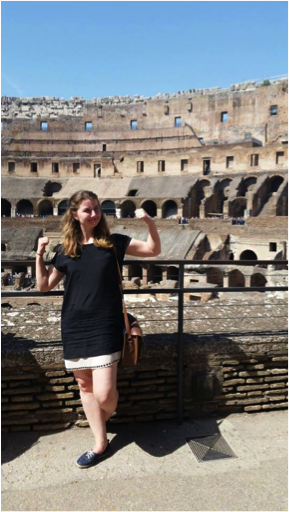
This month’s coin was written by Lucinda Hughes. Lucinda graduated from Warwick in 2014 with a BA in Classical Civilisation, which gave her a continued interest in Greek and Latin literature. She is now studying for an MSc in Business (Finance and Accounting) at Warwick Business School, and begins work at Nomura International in September.
Select Bibliography:
Carey, C (2009) "Genre, Occasion and Performance", in The Cambridge Companion to Greek Lyric, eds. Budelmann (Cambridge University Press, Cambridge).
Davidson, J. (1998) Courtesans and Fishcakes (Fontana Press, London).
Kowalzig (2013) “Dancing Dolphins on the Wine Dark Sea” in Dithyramb in Context, eds. Kowalzig and Wilson (Oxford University Press, Oxford).
Images:
Dolphin coin: © Trustees of the British Museum.
Plate showing Dionysius: "Exekias Dionysos Staatliche Antikensammlungen 2044" by Exekias - MatthiasKabel, Own work, 28 January 2006. Image renamed from Image:Dionysos Augenschale des Exekias.jpg. Licensed under CC BY 2.5 via Commons.
Amphora depicting hoplite warrior with shield: "Athenian red figure Amphora" by Dan Diffendale, own work, 2 September 2005. Licenced under CC BY 2.0 via Flickr.
Hoplite warriors riding dolphins into battle: Reproduced courtesy of the Metropolitan Museum of Art, "Terracotta psykter (vase for cooling wine) attributed to Oltos, accession no. 1989.281.69.
 Clare Rowan
Clare Rowan

 Please wait - comments are loading
Please wait - comments are loading

 Loading…
Loading…

